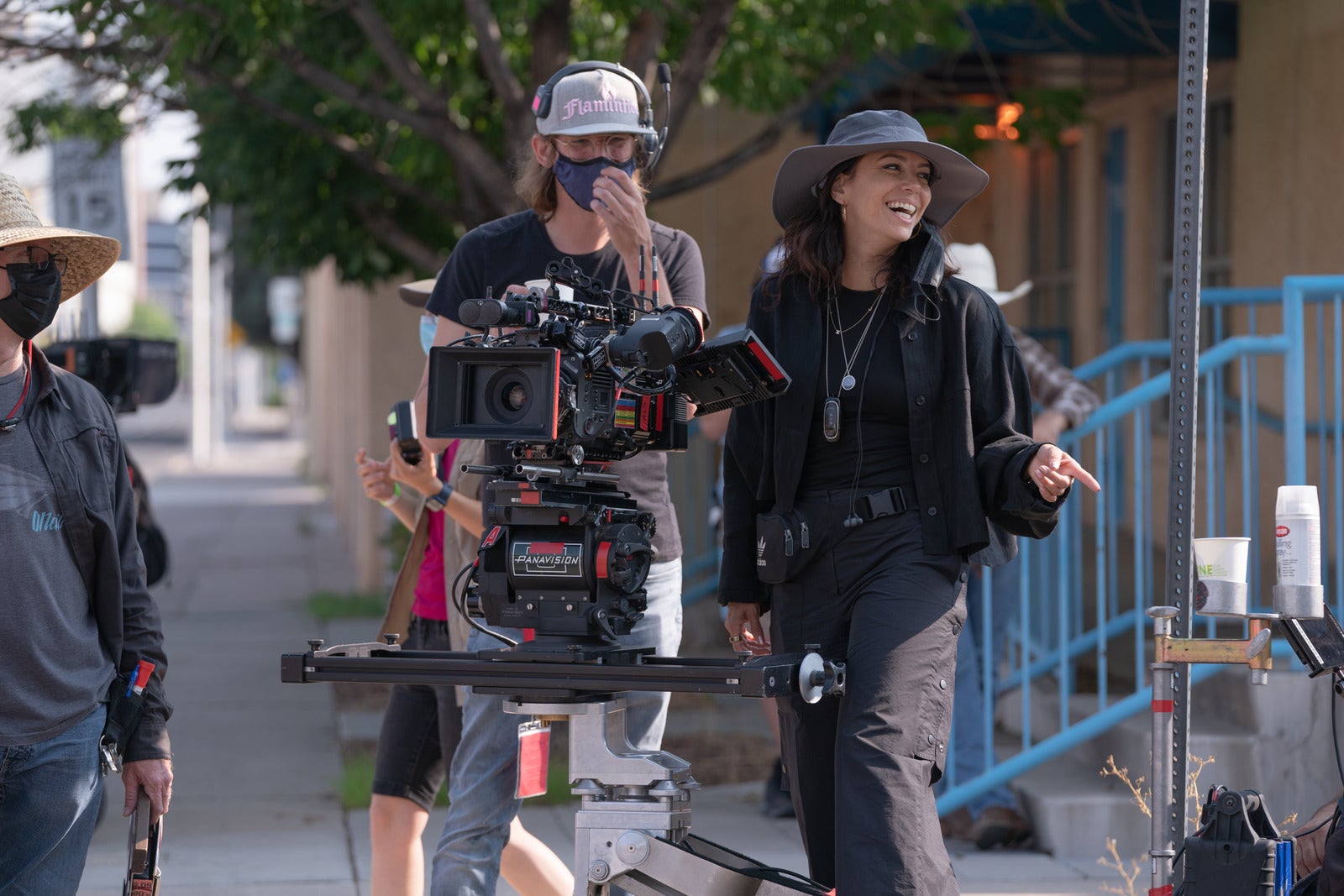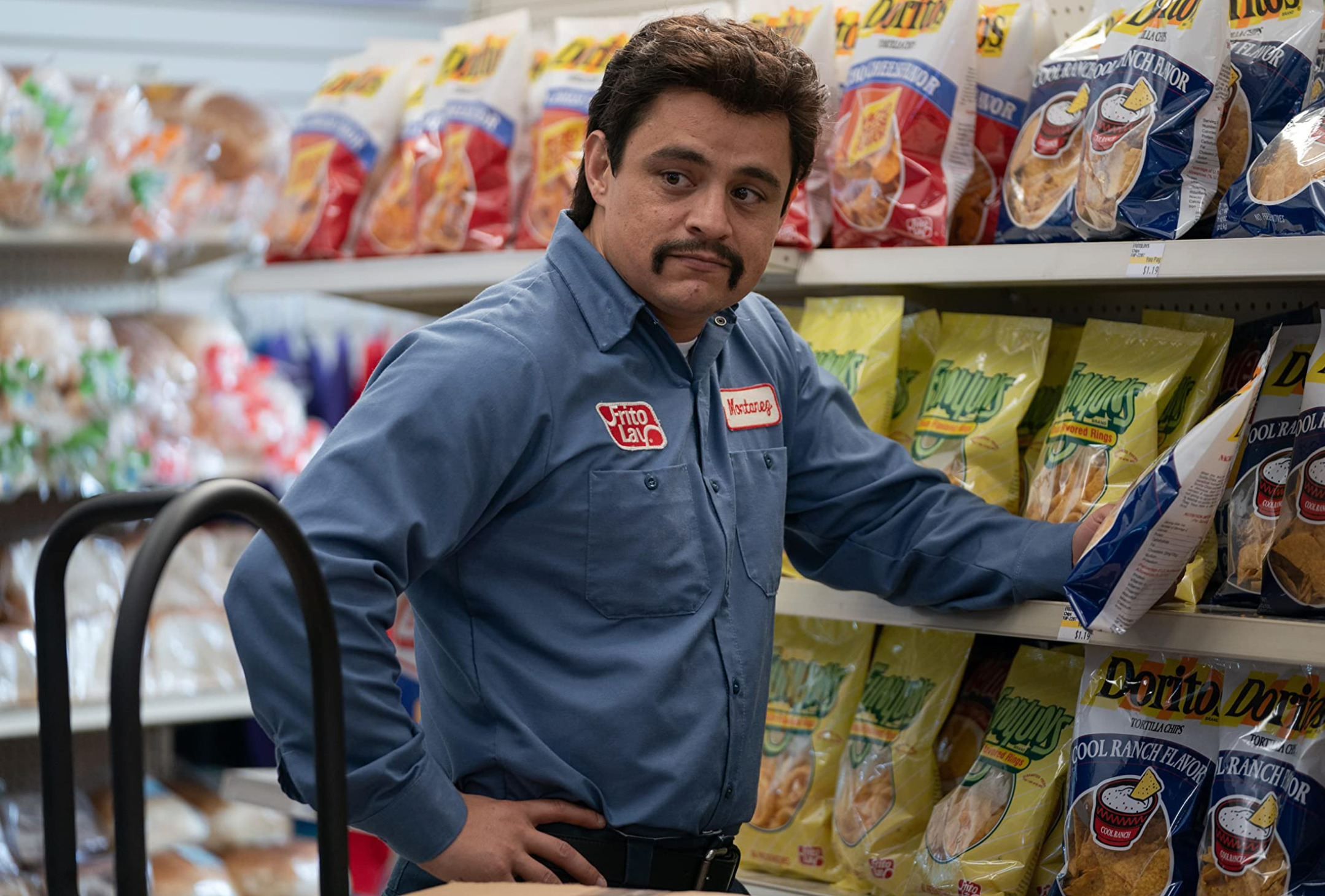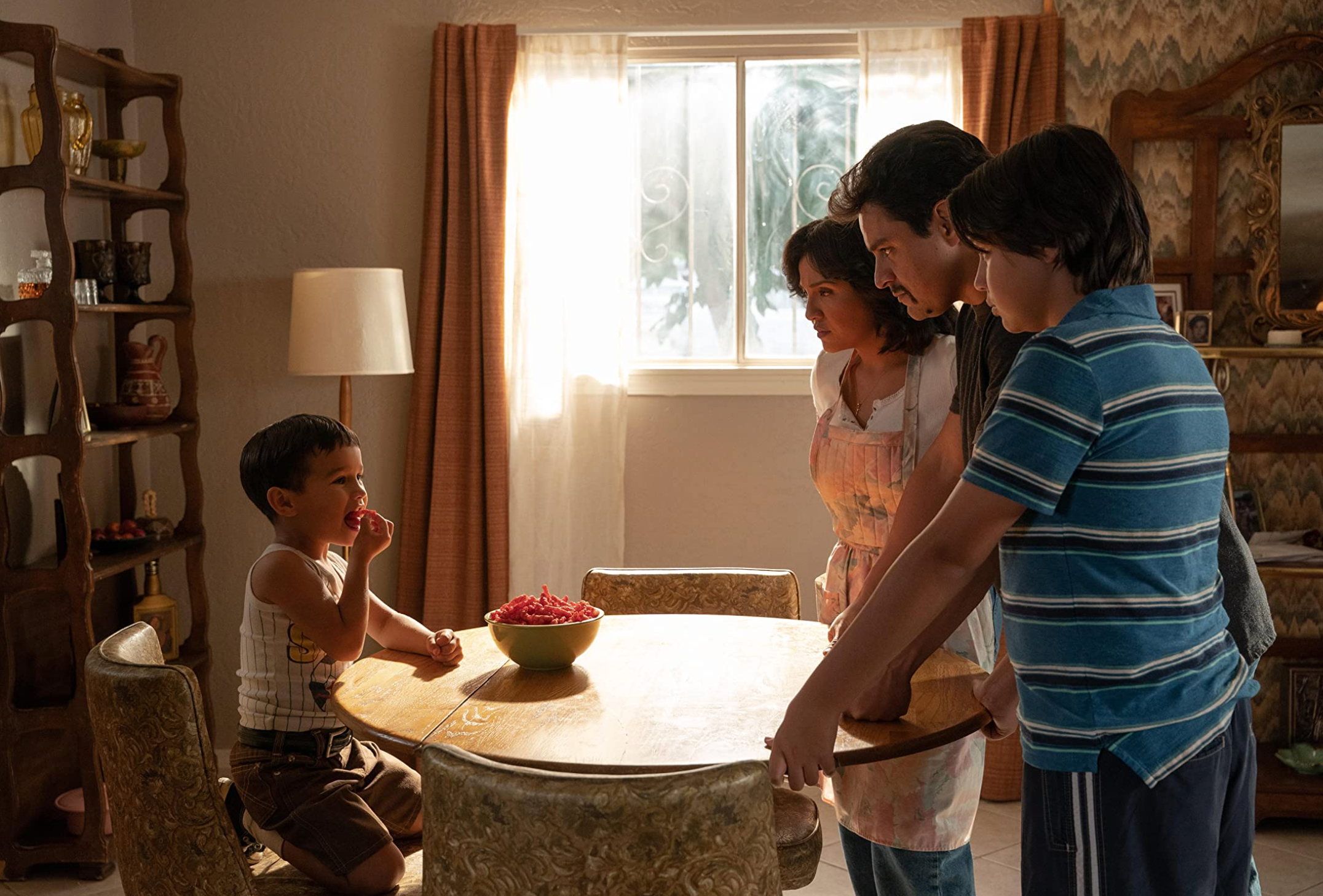
01-06-2024 - News
Shot Deck x Sony: Lawrence Sher ASC sits down with Director Eva Longoria and DP Federico Cantini
By: Oakley Anderson-Moore
Lawrence Sher ASC sat down with Director Eva Longoria and Director of Photography Federico Cantini to break down the look and story of Flamin' Hot in the newest Shot Talk. Watch the talk then read our story!
Eva Longoria wanted Federico Cantini to be the DP of her first feature film as director. What big movies had Cantini shot? None, she told the Studio.
But he had something else to offer: talent, a positive attitude, and the passion to tell the story exactly how it needed to be told. Longoria went to bat for Cantini with Searchlight Pictures until they agreed that he would be a great cinematographer for the film.
Cantini proved them all right.
Flamin’ Hot is the mostly true story of Richard Montañez, a Frito Lay janitor who channeled his Mexican heritage into the invention of the now world-famous crunchy corn puff snack with fiery chile zest. It became the most-watched Searchlight Pictures streaming premiere on Disney+. and was named one of the best films of 2023 by Variety. It’s a film that’s entertaining with heart. It burns – but it burns good.
Cantini sat down with Sony Cine to talk about why the Sony VENICE was hands-down the best choice for the film, and how he worked his way up the camera department in Argentina to the set of Flamin‘’ Hot.

How a childhood trip from Argentina to Universal Studios started Cantini’s film career
When Federico Cantini was 12 years old and living in Argentina with his family, his mom gave him some exciting news. She was going to a psychology convention in Los Angeles, and she was going to take Cantini and his brothers with her.
“We did the Universal Studios thing,” Cantini recalls, “I saw the crews on the streets shooting movies. I saw that, and I thought, ‘Oh, my God. I want to live in this city, and I want to make movies. This is what I want to do!’ It took me manyyears, but everything that I did, it was with that objective in mind.”
Cantini started filmmaking in Buenos Aires at the Universidad del Cine. Then, he startedworking any gig he could get.
“First, I took the worst job ever,” laughs Cantini. “I was a nightshift casting editor. I had to spend the whole night editing casting tapes. At 7:00 AM, I had to put it on VHS and then take the bus to FedEx to send it to the production company and the agency.”
From there, Cantini made his way into the camera department and eventually to shooting commercials in Argentina. Then he got his first gig shooting a commercial in Los Angeles.
“When all the planets align, it's like you have one shot,” says Cantini, “You can tell you have to do it now. And we did it. Six months later, we were living in LA in a garage. That was eight years ago. In a way, it was hard because it was starting all over again from scratch. Then I started to get some commercials. And then I got my first lucky strike, a tiny indie movie, three shooting weeks in Cape Cod. They called me because they had lost their DP two weeks before shooting. We did this movie, and we had a great time.
One year later, one of the producers called me at the last minute during COVID. She had lost their DP again and they need a DP to fly to Tulsa, Oklahoma right away. Again, I said 'Yes!'
I go there, and Eva was the main actress! She loves to speak Spanish and I was the only Spanish speaker on the entire set. So we became very good friends. And some weeks after the wrap, she called me for her movie, Flamin' Hot.”

How Cantini and Eva Longoria won over the Studio
After he got the call from Longoria, it wasn’t a simple greenlight. Cantini only got the gig after he and Longoria had planned out nearly every second of screentime.
“The studio didn't want me at the beginning, because I didn't have a movie at that scope,” explains Cantini, who understood why the Studio would be hesitant. “It was also Eva's first movie, so they wanted her to work with some more seasoned DPs. But she pushed for me for many months. It was a very long approval process with the Studio, until finally they said yes.”
In some ways, the lengthy approval process was a win for Cantini.
“Because I worked so hard to get approved from the Studio, because I had so many Zoom calls with so many studio executives, so many people, trying to get the job, from the moment they approved me, I was able to shoot the next week. I had already thought so much about the movie.”
From the beginning, Cantini had a clear sense of Longoria’s vision.
“We were both thinking about the same references,” says Cantini. “We didn't want to make a super emotional, flat looking movie. But also we didn't want to make it super-hyped, flavor-of-the-month look that in three years was going to look old. We wanted a classic timeless look, but very dynamic, and make it appealing to everyone.
They talked about camera moves, telling the story visually like Spielberg or Scorsese, and adding references like Casino, Goodfellas, and films from Adam McKay. After he was approved, they spent a long 11 weeks in prep.
“My job, during all those weeks, was putting down on paper first. Eva is very methodical, and she works a lot. She needs to have everything ready and on paper before shooting. It was her first movie, and it was my first studio movie, too. We had many eyes on us, so we wanted to be ready. The first three days of production, the studio was on top of us. But then they realized, hey, ’They know what they're doing.' It was by far the best shooting of my life because we had everything ready, shot by shot. We had a huge bible, exactly like director plans, shot lists. We did photo storyboards of the entire movie. So, we had everything, exactly as it would be for the entire movie.”

How Cantini’s vision paired with extensive camera tests led to the Sony VENICE
To tell Richard Montanez’s story, Cantini wanted the camera to capture the shift from a confining upbringing of limited resources to a bigger world of opportunity. In addition, these shifts had to cover an idyllic 1960s, a gritty inner-city 1970s, and a shiny Frito Lay factory of the 1980s.
“Everything had to do with the lenses, the camera,” says Cantini. “I wanted to shoot anamorphic for the childhood scenes because, for me, anamorphics feel like a dream. Even though he had a very rough childhood, Montanez has some nice memories about it, too. I wanted to shoot Super 35 sensor in the 1970s and in his home because I wanted to change to large format when Montanez gets into the factory. I wanted to show how, at the beginning, you feel that the house is super small and tight on him. And then when he gets to the factory, everything is becoming better in his life, everything feels bigger. Even though it's the same house, everything feels a little bit bigger, with more light and with more air. I really wanted to do that. And the only camera that was able to do all that was the Sony VENICE. It was the only camera, for real. I know because I tried all of them.”
Because Cantini had a strong relationship with Panavision Hollywood from shooting commercials and his prior movies, the camera house let him do extensive tests until he found the perfect package for the film. Cantini ended up shooting the Montanez youth in the 1960s with JDC Xtal Xpres anamorphic lenses, the troubled 1970s with Canon K-35 lenses on Super 35 format, and customized Panavision Panaspeed large-format lenses including modified Panavision Primo zooms (a 29-327mm and SLZ 17.5-75mm) for the large-format look inside the Frito Lay factory in the 1980s and on. He even used a few more specialty lenses, like the Laowa 24mm T14 2x PeriProbe lens for shooting inside the Cheetos production.
“We had some shots with the Laowa lens, which is a very, very slow lens. I think the stop is 11 or 14. And we had a lot of night exteriors. With the Sony VENICE, I was always able to shoot ISO 2500.”
To use all of these lenses and shooting formats, Cantini quickly realized only the Sony VENICE could deliver the look he wanted. He went with three Sony VENICE cameras plus a VENICE Extension System for handheld work. Cantini also spoke a lot with Walter Volpatto, the senior colorist of the movie at Company 3.
“He agreed with me about the Sony VENICE. And we created three LUTs for each decade using some curvesimulation of different film stocks. We did the camera test with those LUTs. I hadn’t used the VENICE very much before this film, but I was able to take my trusted DIT, Paul Maletich, who I’ve been working with for the last eight years, to the production in Albuquerque. I didn't know the camera that well, but he did, and I felt assured that everything was going to be okay.”
It turned out to be better than okay.
“The VENICE worked perfectly. We had zero problems. We were in extreme heat. Every day, everything went really good. We had our first AC, Meghan Noce who was great. She always had all the cameras ready. It was a really hard job for an AC, because in the morning, we shoot 4K Super 35 with these lenses. In the afternoon, we go anamorphic. I'm setting the camera; I'm changing the sensor size, the configurations. For example, when Enrico, the PepsiCo CEO, makes his video for the company, we changed the size of the sensor to the smallest possible. I think we shot it 1080i, interlaced, or something to make it look like an old video camera. It really worked. We did so many fun things with the camera. It was hard to get the job, but once we got it, we did whatever we wanted, really.”

Why Cantini chose to shoot in a teeny-tiny house despite some producers skepticism
To Longoria and Cantini, it was important that "Flamin' Hot' look stylized while keeping it real. To pull that off with the lighting came down to picking the right locations - even if it meant someplace small.
“The most important thing about lighting is location,” says Cantini, “Nobody was 100% sure about our decisions, and at the time they were pushing us to get a bigger home for [the main characters]. It's easier to shoot in a bigger house. No. We don't want him to have a huge kitchen, a huge living room. That's not the story we are telling. So, we end up picking a tiny home."
They wanted to be able to move with the camera around the house freely, and since there was not a lot of space for lights, Cantini took a naturalistic approach.
“All the light came in through the window,” describes Cantini. “That's it. Inside, we're just going to have bounces. Maybe, in some scenes, a key light for them, but we kept it natural.
Instead of setting up shots and then seeing how to light it, we did the opposite, we prepared all the scenes and action to work in favor of the natural light. That way, we were able to go fast, and move around the house freely since most of the fixtures were outside.”
For night scenes in the Montañez house, Cantini used tiny magnets to mount litemats to the ceiling.
“We could move them around really quickly. I didn't want to make Eva wait on lighting. I kept everything to the minimum. And that's something that I learned shooting commercials for many, many years. If you have a good camera and you have good lenses, that's it. Then you don't need much more, really.”

How Cantini’s philosophy keeps him having fun on set fun every day, no matter what
For Cantini, coming on as DP of Flamin' Hot was a big opportunity.
“It was Eva’s first movie, and it was my first big movie,” explains Cantini. “We were both in the same place: Nobody had a clear idea of what we were going to deliver. And that's like rocket fuel. I started out at a child, dreaming about moving to LA to make movies like this one. It took me 30 years to get the opportunity. I would do everything in my abilities to make it as good as possible.”
Even though it was a high stakes scenario and a studio feature, Cantini didn’t change anything about how he works. His personal philosophy guided him through production, and is part of why he feels the film works.
“Every single day on set, I'm trying to be as happy and excited as my first day of my life on set,” concludes Cantini. “I remember when I was working as a Second AC. I was a kid at 19. I saw these more seasoned guys. And they were already tired and complaining about everything. I thought, ‘I'm never going to be those guys. I want to try to keep this emotion of my first days, and I'm going to try to have it every single day that I'm on set.’ And I think Eva is the same. She's so much fun. She has such a positive energy. We have the same vibe with that. We are really trying to enjoy, and to use the big opportunity that we had. We understood that we were really lucky, we always stayed positive, and we did our best.”
Check out Flamin’ Hot on Disney+ or Hulu.




